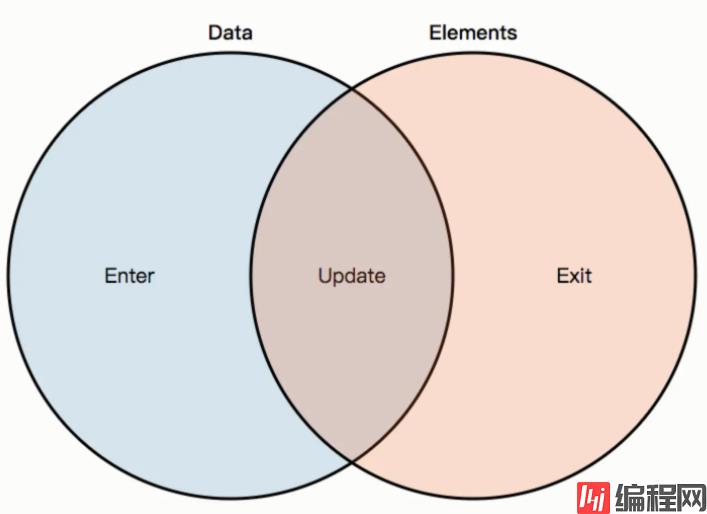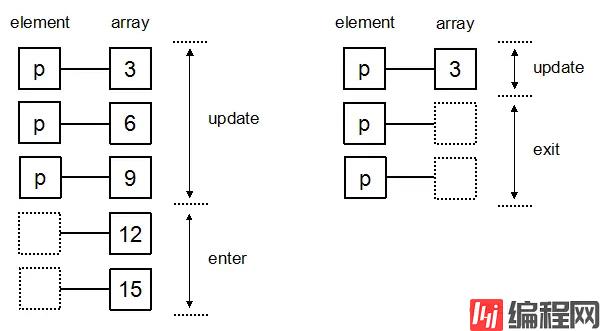目录data、enter、exitdatumjoin最后DataJoin(数据连接)是D3中很重要的一个概念。上一章有提到D3是基于数据操作DOM的js库,DataJoin使我们能够
DataJoin(数据连接)是D3中很重要的一个概念。上一章有提到D3是基于数据操作DOM的js库,DataJoin使我们能够根据现有 html 文档中的数据集注入、修改和删除元素。
上一章中我们用forEach循环的方式,画了三个圆,那么在D3中该怎样优雅的处理呢?
const circles = [
{ text: 1, color: "red" },
{ text: 2, color: "green" },
{ text: 3, color: "blue" }
];
svg.selectAll("circle")
.data(circles) // 绑定数据
.enter() // 获取有数据没dom的集合
.append("circle")
.attr("class", "circle")
.attr("id", (d) => `circle${d.text}`) // d 表示 data绑定的数据中的一项
.attr("cx", (d) => 50 * d.text)
.attr("cy", 50)
.attr("r", 20)
.attr("fill", (d) => d.color);

<div id="dataEnter">
<p></p>
<p></p>
<p></p>
<p></p>
<p></p>
</div>const arr = [1, 2, 3, 4, 5, 6, 7, 8, 9];
const update = d3.select("#dataEnter")
.selectAll("p")
.data(arr)
.text((d) => d);

因为有5个p标签,所以从1开始渲染到5。

enter返回的是有数据没有dom的集合,也就是数据比dom多,所以enter和append基本上都是成对出现的。
d3.select("#dataEnter")
.selectAll("p")
.data(arr)
.enter()
.append("p")
.text((d) => d);

exit返回的是有dom没有数据的集合,也就是dom比数据多,所以exit和remove基本上也是成对出现的。
const arr = [1,2,3]
d3.select("#dataEnter")
.selectAll("p")
.data(arr)
.text((d) => d)
.exit()
.remove();


点击查看data, enter, exit示例
如果datum()绑定的值是数组,那么整个数组会绑定到每个被选择的元素上。
而使用data()的话,那么会依次绑定数据。
const datumDom = d3.select("#datum")
.selectAll("p")
.datum(circles)
.text((d) => {
console.log(d);
return JSON.stringify(d);
});
selection.datum().append()如果选择集是空的,那么并不会添加元素,所以使用datum要确保选择项(dom)存在。实际项目中,图表都是从0到1绘制,所以一般都是使用data().append()。
const arr = [1, 2, 3];
svg.selectAll("circle")
.data(arr)
.join("circle")
.attr("cx", (d) => d * 50)
.attr("cy", (d) => d * 50)
.attr("r", 16)
.attr("fill", "#F89301");
join 根据需要追加、删除和重新排列元素,以匹配先前通过选择绑定的数据,返回合并后的enter和update集合。
也就是说join是一个简化操作,我们可以把join分解一下:
const circle = svg.selectAll("circle").data(arr);
const newCircle = circle.enter()
.append("circle")
.merge(circle)
.attr("cx", (d) => d * 50)
.attr("cy", (d) => d * 50)
.attr("r", 16)
.attr("fill", "#F89301");

这里有一个示例动态的显示了enter(绿色)、update(灰色)、exit(红色)效果:

点击查看 join 示例
以上就是D3.js入门之D3 DataJoin的使用的详细内容,更多关于D3.js DataJoin的资料请关注编程网其它相关文章!
--结束END--
本文标题: D3.js入门之D3 DataJoin的使用
本文链接: https://www.lsjlt.com/news/170973.html(转载时请注明来源链接)
有问题或投稿请发送至: 邮箱/279061341@qq.com QQ/279061341
下载Word文档到电脑,方便收藏和打印~
2024-01-12
2023-05-20
2023-05-20
2023-05-20
2023-05-20
2023-05-20
2023-05-20
2023-05-20
2023-05-20
2023-05-20
回答
回答
回答
回答
回答
回答
回答
回答
回答
回答
0